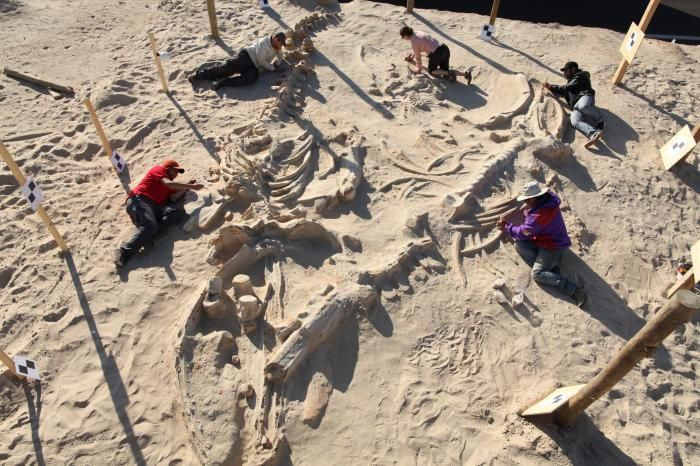Whale Mass-Grave Mystery In The Atacama Desert In Chile Solved, ‘Algae Assassin’ To Blame

The discovery of a whale mass grave in Chile in 2010 left scientists with more questions than answers. Scientists stumbled onto what was described as a crime scene containing the bones of 40 whales, and further investigation finally revealed the culprit: common algae.
Led by Nicholas Pyenson, from the Smithsonian’s National Museum of Natural History, researchers began excavating the Cerro Ballena (Whale Hill) deposit in the Atacama Desert of northern Chile. Much like a scene from “CSI,” the team of scientists acted as forensic investigators to unravel the mystery of the mass grave that holds baleen whales, sperm whales, bony fish, extinct marine mammals, marlins and seals. The deaths occurred in the Late Miocene epoch, approximately 6 million to 9 million years ago.
Cerro Ballena is an interesting site: As it's located next to the Pan-American Highway, the whale fossils were discovered by construction workers. According to Pyenson, the team had only a short time at the site, and part of the research included creating 3D scans of the bones.
The scientists first ruled out a virus that affected only whales, due to the large variety of species present at the scene. Two vital pieces of evidence led to algae being identified as the prime suspect in the marine mammal deaths. The whales were found belly-up, indicating a death at sea, and fossil algae mats with high levels of iron surrounded the bones, which indicated a massive algae bloom.
Based on the evidence, the researchers believe it was a massive harmful algae bloom that killed the marine mammals. Harmful algae blooms occur when algae increase in concentration and can lead to variety of consequences. Certain types of algae that produce toxins increase in concentration or the bloom can reduce oxygen levels or block sunlight, according to the Florida Fish and Wildlife Conservation Commission. HABs can be caused by coastal upswelling or an increase in nutrients that promote the growth of the algae and are also known as red tides.
The study concludes, “We propose that toxins, generated by HABs, poisoned multiple species of marine vertebrates, through ingestion of contaminated prey and/or inhalation, causing relatively rapid death at sea.” The carcasses washed ashore and remained intact due to the lack of predators in the area. The source for the harmful algae bloom is believed to be iron-rich runoff from the Andes along the coast of western South America.
Pyenson said the harmful algae bloom killed marine animals four other times over the course of 10,000 to 16,000 years. The whale mass grave also serves as a snapshot of marine life around South America during the Late Miocene. Pyenson said the discovery at Cerro Ballena is just the beginning and there are plenty of fossils yet to be excavated at the site. “In 240 meters of road cut we can sample fossil marine mammals that pretty much represents everything we know of living in the ocean in South America at that time. That is what is compelling to me,” said Pyenson.
The research was published in the Proceedings of the Royal Society B. A video detailing the whale mass grave, courtesy of the Smithsonian, can be viewed below.
© Copyright IBTimes 2024. All rights reserved.






















